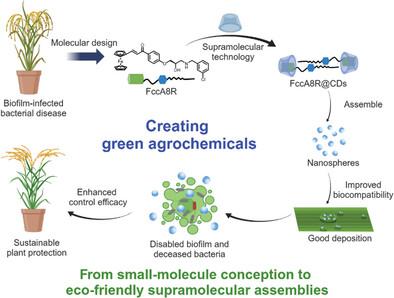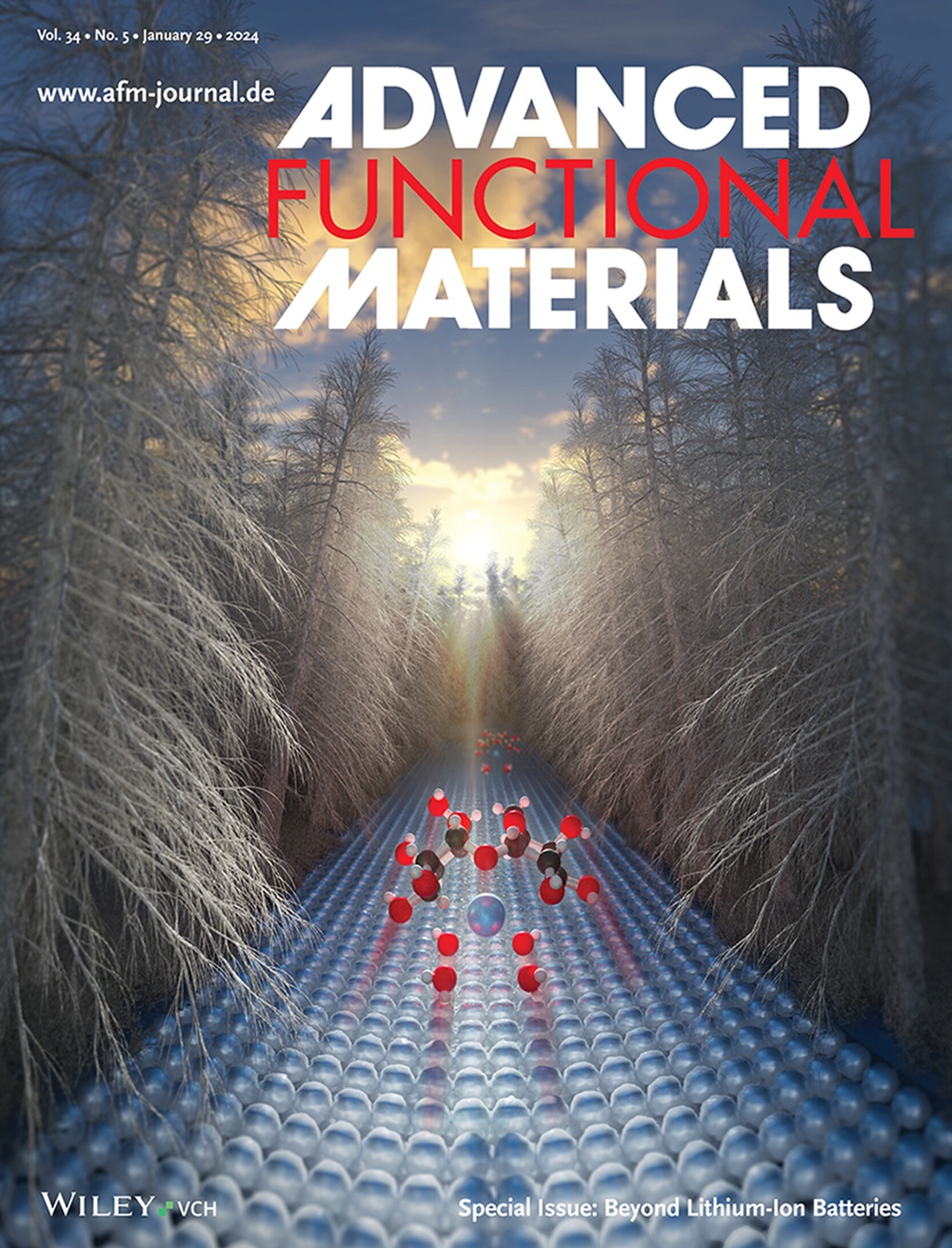从基于二茂铁的原始小分子设计到多功能超分子杀菌剂:在控制生物膜相关细菌感染中的高效应用
IF 18.5
1区 材料科学
Q1 CHEMISTRY, MULTIDISCIPLINARY
引用次数: 0
摘要
传统的杀菌剂在生物膜障碍和疏水性叶片上的低效沉积方面举步维艰,导致对植物细菌病害的控制效果不理想。为了克服这些挑战,我们设想了一种创新的二茂铁基小分子(FccA8R),它具有破坏生物膜的能力。将 FccA8R 与七元寡糖参与的主客体超分子策略进一步优化,创造出两种生物相容性多功能超分子纳米球(FccA8R@β-CD 和 FccA8R@HP-β-CD)。这种操作方法能有效清除成熟的生物膜屏障,同时提高液滴在疏水叶片上的滞留率。在浓度为 56.64 µg mL-1 时,这两种材料对黄单胞菌生物膜的去除率为 76.32%-76.83%,明显超过了单一 FccA8R 的去除率(57.96%)。它们的多功能性还包括增强对细菌运动、胞外酶分泌和外多糖生成的抑制,所有这些都降低了细菌的毒力。在体内盆栽实验中,FccA8R@β-CD 和 FccA8R@HP-β-CD 在 200 µg mL-1 的剂量下对水稻细菌性枯萎病的防治效果为 48.91%-52.03%,优于商品化的硫唑-铜-20%SC(36.42%)和 FccA8R-0.1%Tween (39.54%)。此外,这些超分子组合物对猕猴桃腐烂病的广谱杀菌效力(71.45%-73.19%)显著高于硫唑-铜-20%SC(43.05%)和 FccA8R-0.1%Tween (57.24%)。此外,超分子杀菌剂对植物和斑马鱼、蚯蚓等非靶标生物都是安全的。简而言之,该研究为从小分子构想到生态友好型超分子组装物的绿色杀菌剂的研制奠定了重要基础,实现了细菌疾病防治和环境安全。本文章由计算机程序翻译,如有差异,请以英文原文为准。

From Original Ferrocene-Based Small-Molecule Design to Multifunctional Supramolecular Bactericides: Their Efficient Applications in Controlling Biofilm-Associated Bacterial Infections
Conventional bactericides struggle with biofilm barriers and inefficient deposition on hydrophobic leaves, resulting in undesirable control of plant bacterial diseases. To overcome these challenges, an innovative ferrocene-based small-molecule (FccA8R) is conceived, featuring biofilm disruption capabilities. Further optimizing FccA8R with seven-membered oligosaccharide-involved host–guest supramolecular strategy creates two kinds of biocompatible multifunctional supramolecular nanospheres (FccA8R@β-CD and FccA8R@HP-β-CD). This manipulation efficiently eradicates mature biofilm barriers while enhancing droplet retention on hydrophobic leaves. At a concentration of 56.64 µg mL−1, the two materials remove Xanthomonas-biofilms by 76.32–76.83%, notably surpassing that of single FccA8R (57.96%). Their versatility extends to the enhanced inhibition of bacterial motility, extracellular enzymes secretion, and exopolysaccharides production, all reducing the bacterial virulence. In vivo pot experiments, FccA8R@β-CD and FccA8R@HP-β-CD demonstrate workable control efficacies of 48.91–52.03% against rice bacterial blight at 200 µg mL−1, superior to the commercial thiodiazole-copper-20%SC (36.42%) and FccA8R-0.1%Tween (39.54%). Furthermore, these supramolecular assemblies disclose broad-spectrum bactericidal efficacy (71.45–73.19%) against kiwifruit canker, significantly higher than thiodiazole-copper-20%SC (43.05%) and FccA8R-0.1%Tween (57.24%). Besides, supramolecular bactericides are safe for plants and non-target organisms like zebrafish and earthworms. Briefly, this research builds a key foundation for creating green bactericides from small-molecule conception to eco-friendly supramolecular assemblies, realizing the prevention of bacterial diseases and environmental safety.
求助全文
通过发布文献求助,成功后即可免费获取论文全文。
去求助
来源期刊

Advanced Functional Materials
工程技术-材料科学:综合
CiteScore
29.50
自引率
4.20%
发文量
2086
审稿时长
2.1 months
期刊介绍:
Firmly established as a top-tier materials science journal, Advanced Functional Materials reports breakthrough research in all aspects of materials science, including nanotechnology, chemistry, physics, and biology every week.
Advanced Functional Materials is known for its rapid and fair peer review, quality content, and high impact, making it the first choice of the international materials science community.
 求助内容:
求助内容: 应助结果提醒方式:
应助结果提醒方式:


